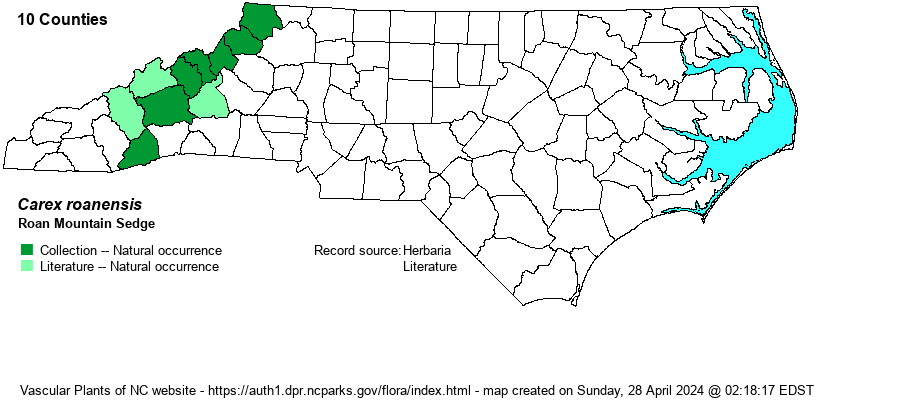| Author | F.J. Hermann | |
| Distribution | Mountains, except for the southwestern corner of the state, where assumed to be truly absent. In the past few decades, our knowledge of the distribution of this species has improved markedly; Wofford (1989) said "known only from Roan Mt., TN, and vicinity".
Southwestern PA, WV, and eastern KY, south to western NC and northwestern GA. | |
| Abundance | Uncommon to locally frequent, despite the NCNHP tracking it as Significantly Rare. Their database contains 35 records of the species, most extant, and with the best populations in the northernmost counties. | |
| Habitat | Northern hardwoods, high elevation oak forests, cove forests; in middle and high elevations only. |
| Phenology | Flowering and fruiting May-June. | |
| Identification | Roan Mountain Sedge belongs to a group with slender, arching or nodding, female spikes. Upper spikes of C. roanensis, however, often do not arch or droop, but remain erect or ascending. As in C. gracillima and C. aestivalis, it has beakless perigynia. C. roanensis can be told from C. gracillima by its pubescent leaf sheaths (vs. glabrous) and from C. aestivalis by its pubescent perigynia (vs. glabrous) and larger achenes (3-4 mm long vs. 2-3.2 mm long). | |
| Taxonomic Comments | None
The genus Carex is the largest in North America, and among the largest in the world. In temperate and boreal regions, Carex is often the dominant or co-dominant ground layer in many habitats. Seeds (achenes) are valuable food for birds and small mammals, while foliage is used by birds and mammals to make nests and as food by mammals. Species of Carex often look vastly different from one another -- spikes erect vs. drooping, tiny inflorescence vs. whopping, culms leafy vs. naked, perigynia beaked vs. beakless, stems densely bunched vs. single, etc. The genus has been divided into many sections (or groups), based on shared characters; some taxonomists have suggested that these be different genera, but that proves unworkable (so far). All Carex share the feature of a perigynium (an outer covering) which completely surrounds the achene (seed). This covering may fit tightly or loosely (like a small bladder), depending on which group or species. Details of perigynia shape, ornamentation, presence and size of beak, number of striations (or veins) are all important ID features. In recent years Rob Naczi and colleagues have stressed the importance of arrangement of perigynia -- whether spiral (3+ ranks) or distichous (2-ranked) -- and have named a number of new species as well as split off some older synonyms. Therefore, RAB's (1968) key, excellent for its time, can only be used in a general way today. Members of some sections of Carex are difficult to key out (notably Ovales, Laxiflorae, Griseae); this is in part due to variation among individuals of a species, or failings of the key. FNA has drawings of most species and some species may be found in two or more places within a key, to acount for variability. New species to NC, and new to science(!), continue to be found in NC. | |
| Other Common Name(s) | None | |
| State Rank | S2 | |
| Global Rank | G3 | |
| State Status | SR-T | |
| US Status | | |
| USACE-agcp | | |
| USACE-emp | | |

